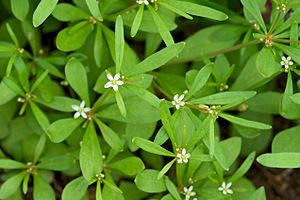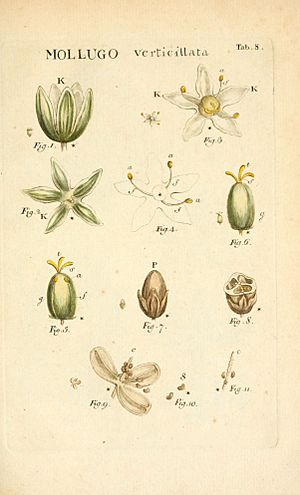Green carpetweed facts for kids
Quick facts for kids Green carpetweed |
|
|---|---|
 |
|
| Conservation status | |
| Scientific classification | |
| Genus: |
Mollugo
|
| Species: |
verticillata
|
| Synonyms | |
|
|
Mollugo verticillata, also known as green carpetweed, is a plant that grows quickly. It is an annual plant, meaning it completes its life cycle in one year. This plant originally comes from tropical America. In eastern North America, you can often find it growing as a weed in places where the ground has been disturbed.
Carpetweed grows in a flat, circular shape, like a mat. It can easily spread over other plants and objects nearby. This plant has been found in almost every state in the United States. It also grows in parts of Canada. Even though it is often seen as a weed, M. verticillata can be eaten. Scientists have found proof that this plant has been in North America for about 3,000 years. It is sometimes called "Indian chickweed." In China, it is known as zhong leng su mi cao.
Contents
What Does Carpetweed Look Like?
Carpetweed has thin leaves that grow in groups around the stem. These groups are called whorls. There are usually 3 to 8 leaves at each point on the stem. When the plant gets older, it might lose its early circular leaf pattern.
Leaves and Growth
The leaves are about 1 to 3 centimeters long. They are shaped like a teardrop, wider at the top and narrower at the bottom. The tip of the leaf can be rounded or pointed. The plant grows flat along the ground, spreading out to form thick mats.
Flowers and Seeds
Carpetweed flowers usually grow in small groups of 2 to 5. They bloom from July through September. The flowers are white or greenish-white. They have tiny stalks that are 5 to 15 millimeters long. After blooming, the flowers quickly turn into small, egg-shaped fruits. These fruits are about 1.5 to 4 millimeters long. When the fruit is ready, it opens up to release the seeds. The seeds are very small, about 0.5 millimeters long, and are red or rusty brown.
How Scientists Classify Carpetweed
Scientists group living things based on how they are related. This helps us understand them better. Mollugo verticillata belongs to a plant family called Molluginaceae. In the past, plants in this family were sometimes grouped with other families. But new studies, using DNA, have helped scientists understand their true relationships.
Plant Family and Names
The group, or genus, called Mollugo includes about 35 different kinds of annual plants. Mollugo verticillata has many other names it has been called over time. These are called synonyms. Some of them include Mollugo dichotoma and Pharnaceum verticellatum. In Spanish, it is called alfombra, and in French, it is called mollugine. Other plants closely related to Mollugo verticillata include Mollugo floriana and Mollugo enneandra.
Where Carpetweed Grows
Mollugo verticillata is found in many places around the world. It grows across North America, and in countries like Brazil, Colombia, and Mexico. You can also find it in the West Indies, Central America, South America, parts of Eurasia, and Africa.
Preferred Environment
Many experts believe that carpetweed first came from the warm, tropical parts of the New World (the Americas). From there, it spread to cooler areas. Generally, it likes to grow in warm and/or wet places. In North America, it is often found in disturbed areas. These include fields, parking lots, and gardens.
How People Use Carpetweed
Some plants in the Molluginaceae family, including Mollugo, can be eaten. People have used them as vegetables or for their health benefits for a long time.
Traditional Uses and Health Benefits
Scientists have studied plants from the Molluginaceae family for their possible health properties. These plants contain special natural chemicals. One study suggested that extracts from M. verticillata might help the body's defense system. In general, plants in this family are known to have properties that can fight against fungi and reduce swelling.
Carpetweed in History
Scientists have found very old M. verticillata seeds. Seeds found in Tennessee were carbon-dated to between 1170 and 140 B.C. Other seeds found in Louisiana were dated to about 500 A.D. This shows that carpetweed was in North America long before Europeans arrived.
Use by Native Peoples
Even though it doesn't seem to have much food value today, Native American peoples may have used M. verticillata in ways we don't fully understand now. In the Southern Appalachian region, indigenous peoples used carpetweed, sometimes called "Indian chickweed," as a potherb. This means they cooked and ate it like a leafy green vegetable.
Is Carpetweed Endangered?
Carpetweed is considered to be a very common and safe plant globally. It is not in danger of disappearing. However, the United States Department of Agriculture (USDA) lists it as an invasive weed. This means it can spread quickly and sometimes take over areas where other plants grow. The IUCN Red List, which tracks endangered species, has not yet evaluated this plant. Some reports say it is native to the US, Caribbean, and Mexico, and was introduced to Canada.



